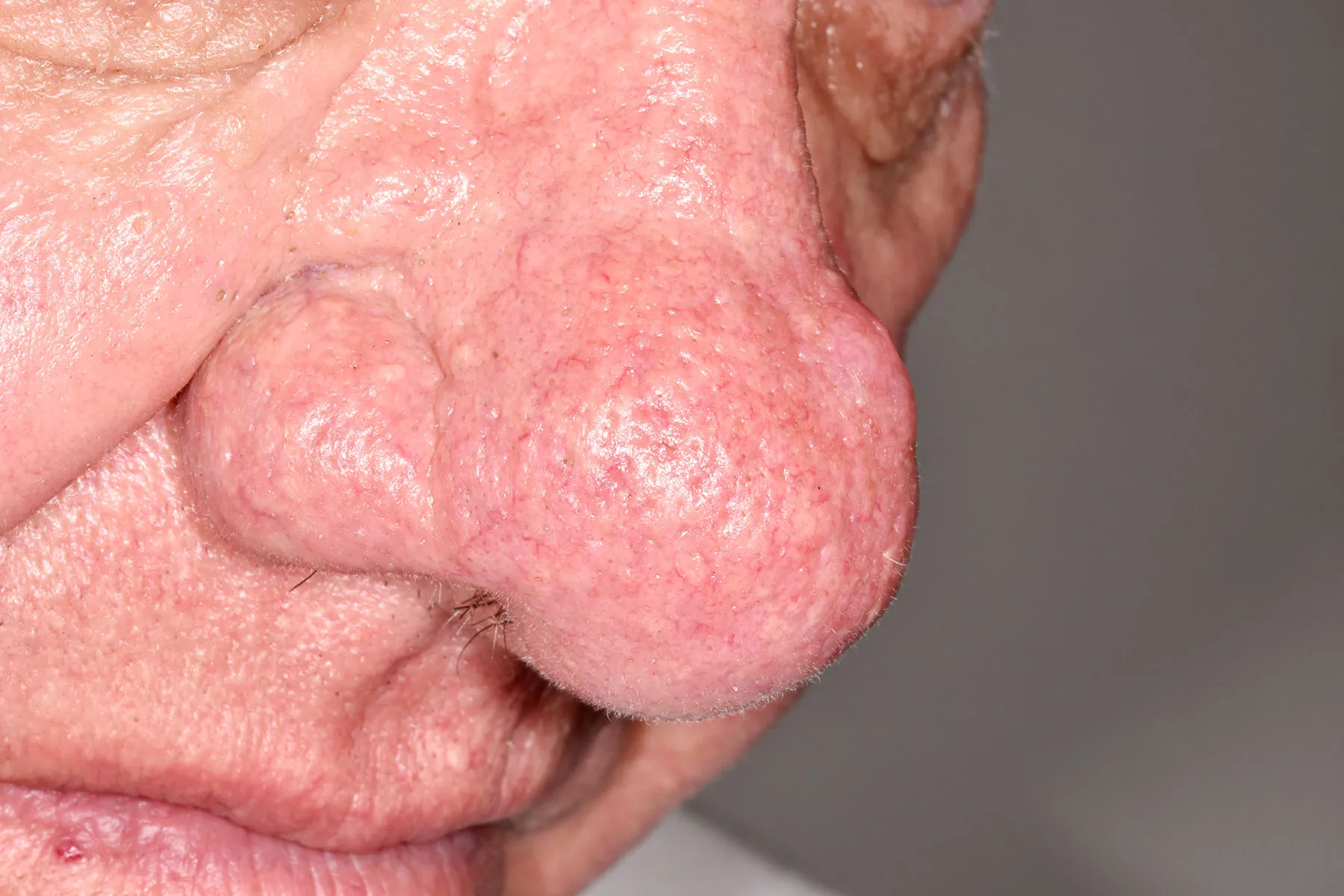Rhinophyma: Causes, Symptoms, and Treatment
Rhinophyma is a skin condition that causes the nose to become enlarged, thickened, and bulbous. While it is not life-threatening, it can significantly affect appearance and self-confidence. Understanding the causes, symptoms, and available treatments can help patients manage the condition and seek the right care.

What Is Rhinophyma?
Rhinophyma is a subtype of rosacea, a chronic skin disorder that often affects the central part of the face. In rhinophyma, the skin on the nose undergoes progressive thickening due to enlargement of sebaceous (oil) glands and connective tissue.
The condition is more common in men than women, especially those over the age of 50. Although rhinophyma is benign, it can cause cosmetic concerns and, in some cases, interfere with nasal breathing if the overgrowth becomes severe.

Causes and Risk Factors
The exact cause of rhinophyma is not fully understood, but it is closely linked with long-standing rosacea. According to the National Rosacea Society and other dermatology sources, several factors may contribute to its development:
-
Chronic rosacea: Rhinophyma usually develops in individuals with untreated or severe rosacea.
-
Excess sebaceous gland growth: Overproduction of oil in the skin leads to thickening.
-
Genetic factors: A family history of rosacea or rhinophyma may increase risk.
-
Gender: Men are more commonly affected than women.
-
Age: Most cases appear after age 50.
-
Skin type: Fair-skinned individuals may have a higher risk.
It is important to note that, contrary to past beliefs, rhinophyma is not caused by alcohol use, although alcohol can trigger rosacea flare-ups.
Signs and Symptoms
Rhinophyma typically develops gradually, with changes becoming more noticeable over time. Common signs include:
-
Thickened skin on the nose
-
Bulbous, enlarged nose shape
-
Irregular surface with nodules and bumps
-
Redness and visible blood vessels (telangiectasia)
-
Oily skin texture
-
Asymmetry of the nose
-
In severe cases, airway obstruction due to excess tissue growth
Since rhinophyma often develops on top of rosacea, patients may also experience flushing, persistent facial redness, and sensitivity of the skin.

How Is Rhinophyma Diagnosed?
A dermatologist can usually diagnose rhinophyma based on a physical examination. In some cases, a skin biopsy may be performed to rule out other conditions, such as basal cell carcinoma or other skin tumors that may mimic rhinophyma.
Because rhinophyma progresses slowly, early recognition and treatment of rosacea can reduce the likelihood of developing advanced forms.
Treatment Options
Although rhinophyma cannot be reversed completely with medications alone, multiple treatment approaches can improve appearance and function.
1. Medical Treatments
-
Topical medications: Creams or gels containing metronidazole, azelaic acid, or ivermectin can help manage rosacea symptoms.
-
Oral antibiotics: Tetracyclines (such as doxycycline or minocycline) may reduce inflammation.
-
Isotretinoin: In severe rosacea cases, this oral medication may help shrink sebaceous glands and slow progression.
Medical treatment is most effective in the early stages, before significant tissue overgrowth occurs.
2. Surgical and Procedural Treatments
When rhinophyma is advanced, surgical or cosmetic procedures are often required to reshape the nose. Options include:
-
Laser therapy: Carbon dioxide (CO₂) or erbium lasers can remove excess tissue and improve skin texture.
-
Dermabrasion: A controlled sanding procedure to smooth the skin.
-
Electrosurgery: Uses electrical energy to cut and reshape thickened tissue.
-
Scalpel surgery: Traditional surgical removal of excess skin and tissue, often followed by reshaping.
These procedures are typically performed by dermatologic surgeons or plastic surgeons, depending on the severity.
3. Supportive Care
-
Sun protection: Using sunscreen daily can reduce flare-ups.
-
Avoiding triggers: Spicy foods, hot beverages, stress, and extreme weather can worsen rosacea and indirectly contribute to rhinophyma.
-
Skincare routine: Gentle cleansing and moisturizing help maintain healthy skin.
Living With Rhinophyma
Rhinophyma can be emotionally challenging, as changes in appearance may affect self-esteem. Patients often benefit from:
-
Dermatology follow-up: Regular visits help monitor rosacea progression.
-
Psychological support: Counseling or support groups may be helpful for those experiencing anxiety or embarrassment.
-
Education: Understanding that rhinophyma is a medical condition—not caused by alcohol—can reduce stigma.
Prognosis
With early treatment, rosacea and rhinophyma can be managed effectively. Surgical procedures often produce excellent cosmetic results and can restore normal nasal function. However, without treatment, rhinophyma may continue to progress.
When to See a Doctor
You should consult a dermatologist if you experience:
-
Persistent redness or thickening of the skin on the nose
-
Noticeable nodules or irregular growths
-
Difficulty breathing through the nose
-
Concerns about the cosmetic appearance of your nose
Early intervention offers the best chance of preventing complications.
Final Thoughts
Rhinophyma may be uncommon, but for those affected, it can have a significant impact on daily life. Fortunately, modern dermatology offers a variety of treatments that can restore both function and confidence. If you or someone you know is experiencing symptoms, a dermatologist can provide personalized guidance and recommend the best treatment plan.


